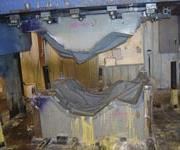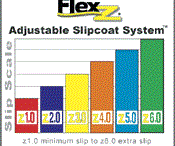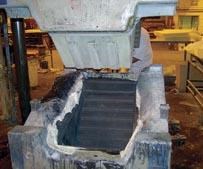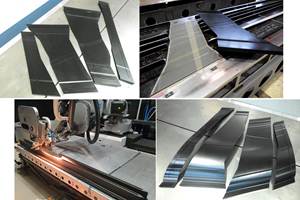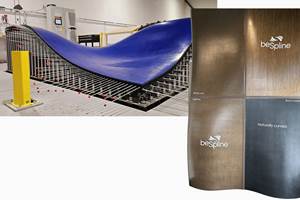Mold release update
New products from mold release manufacturers emphasize ease of use and application flexibility.
Mold release provides the critical barrier between a tooling surface and the materials used to build up a part laminate, enabling separation of the cured part from the mold. "There is no universal best mold release," says Nancy Teufel, technical support manager for Axel Plastics Research Laboratories. "There is only the best product for a particular operation." There are, in fact, four distinct types of release systems: paste wax, liquid polymer, PVA (polyvinyl alcohol) and semi-permanent. Several characteristics are common to all the types. Each forms a chemically inert (that is, nonreactive) film with sufficient heat resistance for its intended processes. Each has surface energy or "slip" calculated to allow the release to thoroughly wet the mold surface when applied, permit the part resin or gel coat to flow and form a consistent film on its dried or cured surface, and enable separation of the cured part. Release types and individual products within the types, vary significantly in regard to slip, application methods, production efficiency and cost. For that reason, composites manufacturers who invest time researching and testing release products may see a return on that investment on the bottom line. Here, CT briefly outlines the distinguishing characteristics of the basic types, with a roundup of recently developed technologies in each category.
WAX & PVA
The earliest releases were paste waxes. More recently, waxes in liquid form (synthetic wax polymers or natural/synthetic combinations) have been developed, which can be hand wiped or sprayed onto the tool. Both forms are widely used today.
Much like the waxes applied to car finishes, these products are applied directly to the mold, allowed to air-dry to the touch, then are buffed to form a smooth, high-gloss barrier. These systems are inexpensive, a plus when fabricating very large, one-off or few-of-a-kind components (e.g., custom yacht hulls). Generally, pastes offer slip sufficient to facilitate demolding, but low enough to allow the use of masking tape, when necessary. Waxes also fill and level small surface imperfections, actually improving the mold surface. While waxes may be used alone on a well-seasoned mold, a PVA parting film is often applied over the buffed wax, as a prudent second line of defense against styrene migration. Exotherm during cure may stimulate migration of styrene from within the mold and within the part itself. (Styrene migration is sometimes evidenced as a hard white buildup on the mold surface, indicating that styrene has penetrated the wax barrier. The presence of the buildup is a sure sign that stripping, sanding and reconditioning is in order.) Parting films are styrene impermeable. In addition, the films provide protection if heat from the part softens the wax, reducing its effectiveness as a barrier. It is also recommended for intricate mold surfaces, where crevices and corners may be hard to reach with wax. Known as "sacrificial" releases, these systems generally are effective for production of one part and must be reapplied after each molding cycle.
PVAs remain on the part after demolding, but are water-soluble, for easy removal. Wax transfer on parts may be removed easily with a conventional degreaser.
The oldest company in the mold release market, Meguiar's (Irvine, Calif.) has supplied products for 103 years and introduced its original #8 paste wax in 1954. Little changed and still widely used, #8 has been joined by the #8 line, featuring pastes reformulated in response to emissions control regulations. Changes to the Velocity line reportedly reduce emissions and compensate for changes in the shrinkage of new lower-VOC gel coats.
Meguiar's emphasizes a "systems" approach in which mold preparation is the key step, offering paste waxes, buffing compounds and polishing agents (the Velocity system is coded for user reference, based on the numerical order in which the products are used in the mold prep.) For new molds, an initial step involves sanding with the company's Unigrit Finishing paper, followed by a buffing with Velocity 80 or 81 compound, depending on the application, to remove sanding marks and prepare the mold surface for polishing with Velocity 82 High Gloss Polish, a water-based product with low-VOC content. (For seasoned molds, mold prep can begin with the polishing step.) Next, several coats of Velocity 83 Mold Sealer are applied and, when dry, are overcoated with Velocity 84 Mold Release, applied in several coats with buffing in between. At this point, the tool is ready to go into production. The company maintains that a good return on the labor investment in the tool surface will be realized in a reduction of rework time after molding.
Meguiar's latest product, Velocity 85LE, is specifically formulated to eliminate one step in mold-prep when using low-emission resins. Its co-polymer technology functions as a sealer and release, and is able to withstand high exothermic temperatures.
A mold release manufacturer since 1953, Rexco Mold Care Products (Conyers, Ga.) produces paste waxes, polyvinyl alcohol (PVA) coatings and buffing compounds for molders of thermoset composites, under the Partall, Marblease and Formula Five brand names.
Rexco recommends the use of its PVA parting film when parts are molded on tools made of composite materials, particularly if the mold is new or has been recently reconditioned. Rexco recommends 2 to 4 mil (dry) parting films on new or reconditioned molds, and at least 1 to 2 mils on seasoned molds.
The Partall line offers several paste waxes and parting films. The newest is the Partall Coverall Film which is a low-VOC, water-based PVA. It is formulated for use as a parting agent for molding composites with either polyester or epoxy matrices, on a variety of mold surfaces. Because it is water-soluble, Coverall use is discouraged with resins that contain water or outgas water during cure (e.g., phenolics). Formulated with relatively high viscosity, the parting film can be hand wiped, sprayed, brushed or rolled, but spraying is recommended to ensure a smooth, high-gloss coating. It is also available with a purple tint in order to confirm consistent and/or uniform application. Its relatively high solids content reduces the number of coats, reducing labor cost.
Partall Film #10 offers similar characteristics, without the VOC reduction, and is available with a green tint. The films may be used on oven-cured parts, at temperatures as high as 149°F/300°F for as long as 45 minutes, or at lower temperatures for longer times (e.g., 93°C/200°F for up to 12 hours). Oven-cured parts, however, will require hot water for film removal. Care must be taken that cure temperatures do not rise above 300°F, initiating carbonization, a process by which molecules in the PVA film may bond with molecules on the mold surfaced.
The newest addition is the Formula Five Liquid Mold Release Wax introduced in November 2004. Formula Five is a low-VOC, aqueous carnauba/silicone-based liquid wax mold release, suitable for most resin systems. It is also effective for touching up mold surfaces between cycles and cleaning deposits from fillet wax and masking tapes on adjustable molds without completely stripping the underlying mold release base. Modified with polymers and specially formulated hydrocarbon waxes, the product features reduced silicone content. Use of a PVA parting film prevents transfer of silicone to part surfaces.
SEMI-PERMANENTS
Like parting films, semi-permanent releases may be hand wiped or applied with a brush, flowcoater or spray equipment, and they provide chemical- and heat-resistant barriers between the mold and part. Unlike wax/parting film systems, semi-permanent mold releases bond to the mold surface rather than the part.
As the designation implies, semi-permanents are intended to remain in useful form on the mold surface for an extended period, enabling production of multiple parts with a single application.
Semi-permanents are reactive resin solutions designed to crosslink and cure on the mold surface to form a film that, when cured, is highly chemical-resistant. Properly applied as a thin film, the films don't transfer to parts and therefore will not interfere with secondary adhesive bonds or the post-mold application of paint or other coatings. Over application, however, may result in transfer, so manufacturers generally recommend training in the product's use.
Semi-permanents can be formulated for target levels of slip, making them the most versatile of the release product families. Their manufacturers typically stock products with a variety of slip levels and/or provide custom formulation services.
A specialist in semi-permanent mold release technology, Zyvax (Boca Raton, Fla.) introduced the first semi-permanents in the early 1960s and developed its first VOC-free semi-permanents in 1985. The company's most recent development is the Flex-Z Adjustable Slipcoat System, a line of six odorless, HAP (hazardous air pollutant)-free mold releases that provide six different degrees of slip in graduated increments. The products are color-coded and numerically distinguished as z1.0 (low slip) through z6.0 (high slip). They may be hand wiped or applied with high-volume/low-pressure (HVLP) spray equipment, reportedly eliminating streaking and buffing.
JB Layman of Zyvax explains, "The Flex-Z family of products shares a root polymer system that can most simply be described as an interpenetrating polymer network (IPN). The Flex-Z IPN is comprised of two distinct polymer networks. One has been crosslinked during synthesis. The other contains both linear and branched polymers that crosslink during cure to form the network. IPNs are characterized by this woven or 'inter- penetrating' structure. The polymer entanglement has excellent adhesion to the substrate and high tensile and flexural strengths." The result is a system of releases, called GLOSSCOAT technology, that form films with "predictable levels of slip," says Layman.
Since the six products are from the same family, different products can be used on the same tool to adjust slip in difficult areas. For instance, a change in slip level may be achieved on an entire mold or a portion thereof, simply by applying a coating of a different Flex-Z level over the Flex-Z Slipcoat already on the surface. Zyvax emphasizes that it is not necessary to strip previous coatings in order to adjust slip levels.
Fiberglass boat manufacturer Sea Ray Boats of Tellico Lake (Vonore, Tenn.) has been using the Flex-Z line for over a year.
Previously, tools were regularly damaged and would need rework after two or three parts. The tool needed to be recoated after every part.
The z4.0 was used initially and is now augmented with the z6.0 in complex areas. With the use of Flex-Z, tool rework is needed every 20 parts, with touch-up only needed after three parts.
Axel Plastics Research Laboratories (Woodside, N.Y.) offers a complete line of mold care products and services, including custom-formulation and technical support during the trials often required to determine the optimum release product and handling procedures for a given application.
Recent development has centered on the company's XTEND line of solvent- and water-based semi-permanents, including the addition of solvent-based 19MDR and water-based WS-86 sealer.
Hap-free 19MDR was formulated for use with urethane resins that have replaced some polyesters, and is designed for SMC, RTM and other closed molding processes where application temperatures range from 50°C to 80°C (122°F to 176°F). According to the company, the fully crosslinking aliphatic hydrocarbon blend cures quickly (less than a minute is needed between application and layup) and does not require the use of a sealer. Additionally, the product is designed to offer high slip and form a highly durable coating that need not be applied after every cycle, thereby reducing build-up. Mold preparation is necessary and consists of several wipe on/wipe off applications to the mold at temperature, prior to layup.
Recently, a manufacturer of decorative architectural components applied 19MDR to RTV silicone molds used to cast both urethane and polyester resins. When no mold release was used, the useful life of a silicone tool was about 150 parts or less, and its release effectiveness declined over the life of the tool as residue built up. With19MDR release (reapplied every 5 to 10 parts, as needed), the molds were still in use three months later -- representing double to triple the previous tool life. Additionally, when parts were analyzed for paint and bond adhesion, 19MDR was judged to have no adverse effect.
The WS-86 Sealer is a HAP-free, low odor semi-permanent aqueous mold sealer that forms a uniform dry film. This product is intended as a base coat for semi-permanent releases, specifically to fill in porosity in aluminum tools.
A mold release source since 1954, The McLube Div. of McGee Industries (Aston, Pa.) today offers a large number of semi-permanent release products and develops new systems continually, as customer needs dictate. McLube emphasizes its customer assistance philosophy, recognizing that the large number of factors that can affect release require intensive technical support.
The company's latest release technologies are high-temperature releases based on polytetrafluoroethylene (PTFE), fluorochemical and resin-based formulations that contain no silicones, surfactants or waxes and can be formulated for thermal stability to 538°C/1000°F. (PTFE technology also is used to manufacture antistick coatings for cookware.)
McLube offers PTFE-based semi-permanents in both solvent-based and water-based formulations for use with conventional polyester, vinyl ester and epoxy resin systems and (because PTFE is unaffected by water give-off during cure) phenolics as well, plus thermoplastics and high-temperature resins such as polyimide and PEEK. The solvent-based releases range from hard, dry bonded fluorocarbon coatings for elastomers and plastics to clear, dry non-flourocarbon general purpose coatings. Its water-based formulations range from products with varying PTFE dispersions to unique fluorochemical blends for elastomers, rubbers and plastics. McLube 2100, for example, is described as a "colloidal dispersion of PTFE in water." McLube 1700L provides PTFE film in a solvent-based formulation. Version 1725L is formulated for a variety of composite materials and process (filament winding, RTM, injection molding, etc.) and is recommended for use when pulling molds form master models.
In response to environmental mandates, Henkel Corp. (formerly Loctite Corp., Rocky Hill, Conn.) is developing a new family of release products designed to dramatically reduce VOC content. According to published reports, the company expects to reduce VOC content in the new products from 69 to 96 percent (depending on the formulation) compared to their predecessors. First offerings are low-VOC versions of its Frekote WOLO (wipe-on/leave-on) and SOLO (spray-on/leave-on) semi-permanents.
Like its conventional version, the new, low-VOC Frekote WOLO-LV is designed for use with all polyester resins. Frekote WOLO can be hand-applied and dries to a high gloss without polishing. The product is solvent-based (an aliphatic hydrocarbon), enabling quick cure at room temperature (five minutes between a minimum of four coats, with only a 15 minutes cure after the final coat before use). The resulting film is reportedly thermally stable at cure temperatures as high as 204°C/400°F.
The spray-on/leave-on version, Frekote SOLO-LV, reportedly will duplicate the performance of its conventional counterpart. Formulated for gel-coated glass-reinforced or filled polyester resins, the release produces a cured film that retains the gloss level of the mold surface. A minimum of seven coats must be applied to new molds. Reapplication requires five coats, but coats need not fully cure between applications. The solvent in the wet film evaporates very quickly and succeeding coats may be applied when previous coats are dry to the touch. Following the final coat, 20 to 30 minutes is required for cure prior to application of gel coat. Both products may be touched up and rebuffed between cure cycles.
SACRIFICIALS AND SEMI-PERMANENTS
Several manufacturers have recently developed new products in both wax and semi-permanent formulations. Chemlease, a subsidiary of Chem-Trend (Howell, Mich.), has released several new Chemlease-branded products as a result of changes in customer and market needs. Chem-Trend also underscores its customer support services, which include custom formulation. In 2003, for example, Chem-Trend dedicated a team of technicians and chemists -- an increasingly common practice among release formulators -- to development of a new sacrificial mold release system, designed to allow a carbon fiber automobile hood to be painted in a General Motors paint line without surface preparation. This not only significantly reduced labor, but also provided the consistent paint quality required by General Motors.
New products include Chemlease Hydrolease, a "wipe-on/buff-off" semi-permanent. It offers low-slip, which enables successful layup in open molding processes and is designed to yield a high-gloss Class A finish even on the toughest gel coats in the market. Also new to the FRP market is solvent-based Chemlease One FS, which is a wipe-on, leave-on release, recommended for marine, cultured marble and solid surface applications. Both products also are recommended for open molding of advanced composites (e.g., carbon/epoxy). Cure times are comparable: 10 minutes between coats, and the mold may be used one-half hour after the final application.
Chemlease 5015W and Chemlease 5016W offer new sacrificial water-based releases for non-Class A applications in the advanced composites market. These products work well with a wide variety of prepregs and are silicon-free. Any transfer cleans easily from the part surface allowing painting or bonding.
Offering sales and service in 29 countries, including mainland China, TR Industries (South Gate, Calif.) offers both semi-permanents and waxes in paste and liquid form. Formulated for use in molding fiber-reinforced plastics (FRP) and cultured marble, the company's 3-Star products include releases, buffing compounds and polishes.
For its wax products, TR recommends detailed mold preparation, beginning with sanding to impart a smooth, satin finish. Next, the surface is further improved by buffing out sanding marks with TR 309 or 311 buffing compounds, designed for fast cutting and a uniform, highly polished finish. After buffing, a mold sealer is recommended. TR 301 offers a blend of glaze and sealers to close mold pores while producing a high gloss. Finally, paste wax is applied and buffed. TR offers several waxes for different purposes including Regular, High-Temp and TR #108 which offers a deeper wax coating for new tools.
For use only on well-seasoned and, in the case of composite tooling, fully cured mold surfaces, TR offers several liquid waxes geared for high-temperature curing. TR-212 H.O.T. (High Operating Temperature) Liquid Release Agent features a "nearly frictionless dry lubricant dispersed in a nonflammable solvent medium" suitable for metal, epoxy or polyester FRP molds. The silicone-free formulation minimizes transfer and reportedly remains stable at temperatures as high as 260°C/500°F.
The company's line of 900 Series semi-permanent polymer-based releases can be used in wipe-on or spray-on application, with most requiring no secondary buffing. Each product in the 900 Series is formulated to work with a wide range of molding processes and materials. TR offers support in choosing the proper release agent in the series. TR-920 semi-permanent provides high-temperature performance, making it suitable not only for multiple releases of parts with polyester and epoxy matrices, but with polyimides as well, and it can be used with BMCs and SMCs compression or injection molding processes. For composite molds, TR-910 semi-permanent mold sealer is recommended as a base coat before application of semi-permanent releases, to block styrene migration.
Related Content
Plant tour: Airtech International, Springfield, Tenn., U.S.
Fifty years of supplying materials for composites manufacturing includes custom fabrication and now aims to advance 3D-printed tooling, parts and new resins.
Read More3D-printed CFRP tools for serial production of composite landing flaps
GKN Aerospace Munich and CEAD develop printed tooling with short and continuous fiber that reduces cost and increases sustainability for composites production.
Read MorePlant tour: BeSpline/Addcomp, Sherbrooke, QC, Canada
Composites automation specialist increases access to next-gen technologies, including novel AFP systems and unique 3D parts using adaptive molds.
Read MoreNorco GFRP molds meet high-quality cast concrete beam production needs
A project with P&M successfully achieved manufacture of six 20-meter-long architectural beams for an R&D facility with near-seamless surfaces and on a tight production schedule.
Read MoreRead Next
Developing bonded composite repair for ships, offshore units
Bureau Veritas and industry partners issue guidelines and pave the way for certification via StrengthBond Offshore project.
Read More“Structured air” TPS safeguards composite structures
Powered by an 85% air/15% pure polyimide aerogel, Blueshift’s novel material system protects structures during transient thermal events from -200°C to beyond 2400°C for rockets, battery boxes and more.
Read MorePlant tour: Daher Shap’in TechCenter and composites production plant, Saint-Aignan-de-Grandlieu, France
Co-located R&D and production advance OOA thermosets, thermoplastics, welding, recycling and digital technologies for faster processing and certification of lighter, more sustainable composites.
Read More



